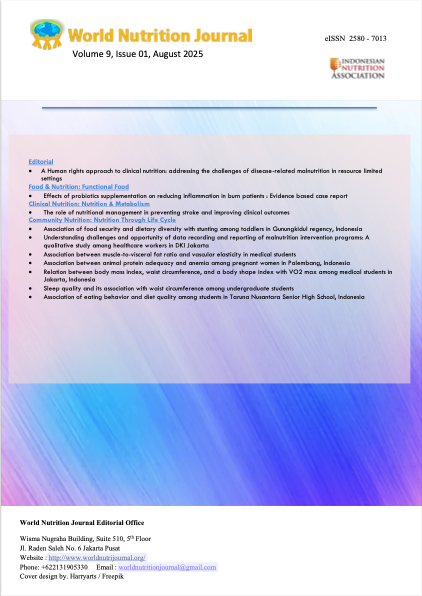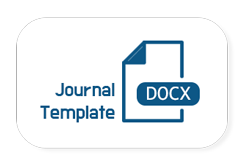Association of food security and dietary diversity with stunting among toddlers in Gunungkidul regency, Indonesia
Abstract
Background: Stunting is impaired child growth due to prolonged undernutrition. In 2022, Indonesia’s stunting prevalence was 21.46% (SSGI), with Gunungkidul regency in Yogyakarta, Indonesia experiencing the highest rate at 23.5%. food security and dietary diversity can influence the occurrence of stunting in toddlers. Objective: This study aims to determine the association of food security and dietary diversity with stunting among toddlers in Gunungkidul Regency. Methods: This cross-sectional study was conducted in the Wonosari and Gedangsari District, Gunungkidul Regency. The sample of this study were 105 children from 6 Posyandu (integrated health care center), which were selected based on the stunting prevalence. The sample were selected using quota sampling techniques. Household food security was assessed using a questionnaire adapted from the 2012 USDA Household Food Security Survey Module, and dietary diversity was assessed using a questionnaire adapted from the 2011 Food and Agriculture Organization (FAO) guidelines. Data were analyzed using the Chi-Square test. Results: More than 30% of the children were stunted (31.4%), 51.5% had dietary diversity in the low and medium categories, and 44.8% of respondents come from food insecure families. There was a significant relationship between dietary diversity and stunting (p<0.05), however the relationship with food security was not statistically significant (p>0.05). Conclusion: Dietary diversity is significantly associated with stunting among toddler however food security is not related to stunting. Caregiver education promoting diverse toddler diets, especially local foods, is needed.Downloads
References
Mahardhika F, Malonda NS., Kapantow NH. Hubungan Antara Usia Pemberian Makanan Pendamping Asi (MP- ASI) Pertama Kali dengan Status Gizi Anak Usia 6-12 Bulan di Wilayah Kerja Puskesmas Kombos Kota Manado. Fakultas Kesehatan Masyarakat Universitas Sam Ratulangi. 2018;7(3):1–7.
Khulafa’ur Rosidah L, Harsiwi S. Hubungan status gizi dengan perkembangan balita usia 1-3 tahun (Di Posyandu Jaan Desa Jaan Kecamatan Gondang Kabupaten Nganjuk). Jurnal Kebidanan. 2019;6(1):24– 37.
Catur Utami D, Nur Azizah A, Nur Azizah A. Hubungan Status Gizi Dengan Perkembangan Balita Usia 1-5 Tahun Di Wilayah Kerja Puskesmas Kutasari. Avicenna: Journal of Health Research. 2023;6(1):28.
World.Nutr.Journal | 27
World Nutrition Journal 2025, 9(1). DOI: 10.25220/WNJ.V09.i1.0003
7.
10.
15. 16.
Yuliantini E, Kamsiah K, Maigoda TC, Ahmad A. Asupan makanan dengan kejadian stunting pada keluarga nelayan di Kota Bengkulu. AcTion: Aceh Nutrition Journal. 2022;7(1):79.
Eldrian F, Karinda M, Setianto R, Dewi BA, Guzmira YH. Hubungan Riwayat Penyakit Infeksi Dengan Kejadian Stunting Pada Balita di Puskesmas Cipadung Kota Bandung. Jurnal Manajemen Kesehatan. 2023;9(1):80–9.
Pratiwi R, Sari RS, Ratnasari F. Dampak Status Gizi Pendek (Stunting) terhadap Prestasi Belajar. Jurnal Ilmu- Ilmu Keperawatan. 2021;12(2):10–23.
Kementerian Sekretariat Negara Republik Indonesia. Peta Jalan Percepatan Pencegahan Stunting Indonesia 2018-2024. TP2AK Sekretariat Wakil Presiden Republik Indonesia. 2020;1–24.
Kementerian Kesehatan. Hasil Survei Status Gizi Indonesia (SSGI) 2022. Kementerian Kesehatan. 2022;1– 150.
Dinas Kesehatan. Profil Kesehatan D.I.Yogyakarta Tahun 2022. Dinas Kesehatan DIY. 1859. 11–16 p.
Arlius A. Hubungan Ketahanan Pangan Keluarga Dengan Status Gizi Balita (Studi Di Desa Palasari Dan Puskesmas Kecamatan Legok. Jurnal Ketahanan Nasional. 2017;23(3):359–75.
Lestari TD, Gunarto T, Yuliawan D. Cigarette Consumption, Credit Access, And Determinants Household Food Security in Lampung Province. Jurnal Ekonomi Pertanian. 2023;16(2):139–48.
Riani. Hubungan Pendapatan Keluarga dengan Status Gizi Balita di Desa Kualu Wilayah Kerja Puskesmas Tambang Kabupaten Kampar Tahun 2018. Jurnal Ners. 2018;2(1):102-106.
Islamiah WE, Nadhiroh SR, Putri EBP, Farapti, Christiwan CA, Prafena PK. Hubungan Ketahanan Pangan Dengan Kejadia Stunting Pada Balita dari Keluarga Nelayan. Media Gizi Indonesia (National Nutrition Journal). 2022;17(1SP):83–9.
United Nations Children's Fund. The State of the World’s Children A Fair Chang Every Child. United Nations Children's Fund. 2016.
Fedriansyah D, Paramashanti BA, Paratmanitya Y .
Faktor Sosial Ekonomi Dan Stunting Pada Anak Usia 6- 23 Bulan. Media Gizi Pangan. 2020;27(1):22–9.
Gassara G, Lin Q, Deng J, Zhang Y, Wei J, Chen J. Dietary Diversity, Household Food Insecurity and Stunting among Children Aged 12 to 59 Months in N’Djamena—Chad. Nutrients. 2023;15(3):1–14.
Gizi Makro pada Balita dari Ibu Bekerja dan Ibu Tidak
Bekerja. Amerta Nutrition. 2021;5(3):276.
Labadarios D, Mchiza ZJR, Steyn NP, Gericke G, Maunder EMW, Davids YD, et al. Food security in South Africa: A review of national surveys. Bull World Health
Organ. 2011;89(12):891–9.
Pujiyanti BR, Anggraeni AD. Hubungan Ketersediaan
Keanekaragaman Pangan Dan Lingkungan Rumah Sehat Terhadap Status Gizi Pada Balita Usia 24-59 Bulan Di Desa Cindega Kec. Kebasen Kab. Banyumas. Journal Health Research Science. 2022;2(02):155–65.
Munnawarroh F, Murni D, Susmiati S. Sosio Ekonomi Dan Skor Keragaman Makanan Terhadap Kejadian Stunting. Link. 2022;18(1):29–36.
Nirmala Sari MR, Ratnawati LY. Hubungan Pengetahuan Ibu tentang Pola Pemberian Makan dengan Status Gizi Balita di Wilayah Kerja Puskesmas Gapura Kabupaten Sumenep. Amerta Nutrition. 2018;2(2):182.
Kementerian Kesehatan RI. Peraturan Menteri Kesehatan Republik Indonesia No. 2 Tahun 2020 tentang Standar Antropometri Anak. Kementerian Kesehatan RI. 2020.
Nurfaradila T. Status Ketahanan Pangan Rumah Tangga dan Pola Asuh Sebagai Faktor Risiko Kejadian Stunting Pada Balita Usia 24-59. Repositori Universitas Jember. 2019–22.
World Health Organization and United Nations International Children's Emergency Fund. Indicators for assessing infant and young child feeding practices. Vol. WHA55 A55/, World Health Organization and the United Nations Children’s Fund. 2021. 19 p.
Food and Agriculture Organization. Guidelines for measuring household and individual dietary diversity. FAO. 2011. 1–60 p.
United Nations Children's Fund. Conceptual Framework on Maternal and Child Nutrition. Nutr Child Dev Sect Program Gr 3 United Nations Plaza New York, NY 10017, USA. 2021;2–3.
World Health Organization. WHO Guideline for complementary feeding of infants and young children 6– 23 months of age. WHO. 2023.
Solomon D, Aderaw Z, Tegegne TK. Minimum dietary diversity and associated factors among children aged 6-23 months in Addis Ababa, Ethiopia. International Journal Equity in Health. 2017;16(1):1–9.
Harper A, Rothberg A, Chirwa E, Sambu W, Mall S. Household Food Insecurity and Demographic Factors, Low Birth Weight and Stunting in Early Childhood: Findings from a Longitudinal Study in South Africa. Maternal Child Health Journal. 2023;27(1):59-69.
Lye CW, Sivasampu S, Mahmudiono T, Majid HA. A systematic review of the relationship between household food insecurity and childhood undernutrition. Journal Public Health (United Kingdom). 2023;45(4):e677–91.
Mulu E, Mengistie B. Household food insecurity and its association with nutritional status of under five children in Sekela District, Western Ethiopia: A comparative cross-sectional study. BMC Nutr. 2017;3(1):1–9.
Masrin, Paratmanitya Y , Aprilia V . Ketahanan pangan rumah tangga berhubungan dengan stunting pada anak usia 6-23 bulan. Jurnal Gizi dan Dietetik Indonesia. 2014;2(3):103–15.
Dinas Pertanian dan Pangan. Laporan Kinerja Instansi Pemerintah Dinas Pertanian dan Pangan Kabupaten Gunung Kidul Tahun 2023. Dinas Pertanian dan Pangan. 2024;7(2).
Sari HP, Permatasari L, Putri WAK. Perbedaan Keragaman Pangan, Pola Asuh Makan, dan Asupan Zat
World.Nutr.Journal | 28
World Nutrition Journal 2025, 9(1). DOI: 10.25220/WNJ.V09.i1.0003
Chandrasekhar S, Aguayo VM, Krishna V, Nair R. Household food insecurity and children’s dietary diversity and nutrition in India. Evidence from the comprehensive nutrition survey in Maharashtra. Maternal Child Nutrition. 2017;13(January):1–8.
Sanggelorang Y, Sebayang FAA, Rumayar AA. Kajian Ketahanan Pangan Rumah Tangga Dan Stunting Di Daerah Pedesaan Pesisir Dan Pulau Kecil Terluar. Jurnal Kesehatan Masyarakat. 2024;8(April):1272–80.
Rahmatika T, Pangestuti DR, Asna AF. Hubungan Ketahanan Pangan , Pola Asuh , dan Tingkat Kecukupan Gizi dengan Kejadian Stunting Balita 6-59 Bulan di Puskesmas Dawe , Kabupaten Kudus. Amerta Nutrition. 2024;8(3):82–93.
Dinku AM, Mekonnen TC, Adilu GS. Child dietary diversity and food (in)security as a potential correlate of child anthropometric indices in the context of urban food system in the cases of north-central Ethiopia. Journal Health Population Nutrition. 2020;39(1):1–11.
Prasetyo A, Davidson SM, Sanubari TPE. Correlation between Individual Dietary Diversity and Children 2-5 Years Old Nutrition Status in Batur Village, Getasan Regency, Semarang District. Amerta Nutrition. 2023;7(3):343–9.
Prastia TN, Listyandini R. Keragaman pangan berhubungan dengan stunting pada anak usia 6-24 bulan. Jurnal Kesehatan Masyarakat. 2020;8(1):33–40.
Hendryanti DN, Andriani C, Indriani S, Gunawan L, Sibero MT. Dietary Diversity, Stunting, and the Impact of an Education Program on Parents’ Knowledge and Attitudes in West Sumba, Indonesia. Jurnal Gizi dan Pangan. 2023;18(2):79–88.
Sie A, Tapsoba C, Dah C, Ouermi L, Zabre P, Barnighausen T, et al. Dietary diversity and nutritional status among children in rural Burkina Faso. International Health. 2018;10(3):157–62.
Kementerian Kesehatan RI. Peraturan Menteri Kesehatan Republik Indonesia No. 41 tahun 2014 tentang pedoman gizi seimbang. Kementerian Kesehatan RI. 2014.
Mank I, Vandormael A, Traore I, Ouedraogo WA, Sauerborn R, Danquah I. Dietary habits associated with growth development of children aged < 5 years in the Nouna Health and Demographic Surveillance System, Burkina Faso. Nutrition Journal. 2020;19(1):1–14.
Submitted
Copyright (c) 2025 Rindi Nuryani, Yhona Paratmanitya, Veriani Aprilia

This work is licensed under a Creative Commons Attribution 4.0 International License.
World Nutrition Journal provides immediate open access to its content under the Creative Commons Attribution License (CC BY 4.0). This permits unrestricted use, distribution, and reproduction in any medium, provided the original work is properly cited.













